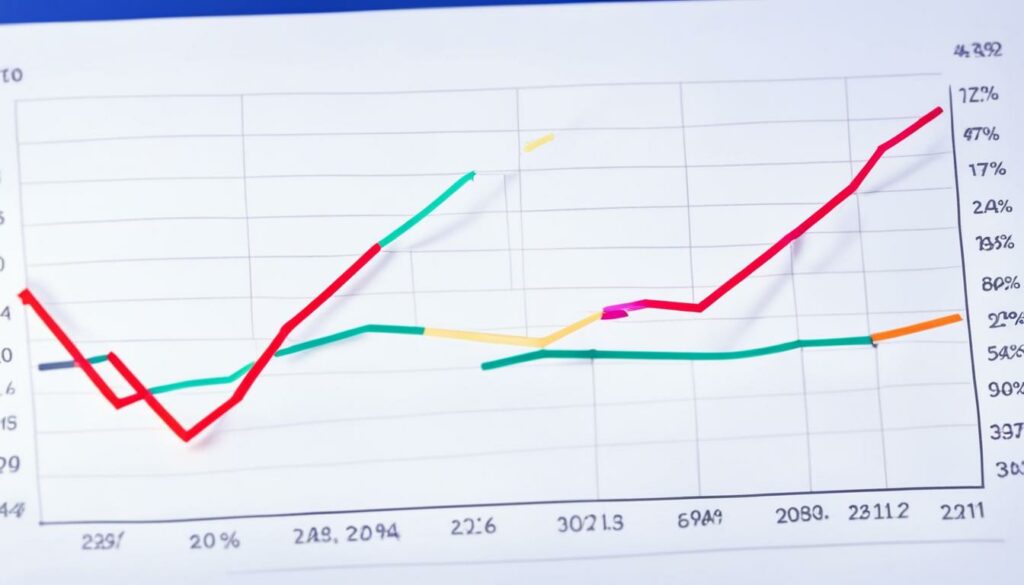Dividends are an essential aspect of the stock market and investment income. In the realm of ecommerce, dividends are payments made by companies to their shareholders as a way to share profits.
Dividends can be distributed in two forms: cash or additional shares of stock, known as a stock dividend. The amount distributed is typically determined by the company’s dividend policy and its overall financial performance.
Key Takeaways:
- Dividends are payments made by companies to their shareholders to share profits.
- In ecommerce, dividends can be in the form of cash or additional shares of stock.
- Dividend yield, calculated by dividing the company’s annual dividend by the stock price, is used to compare dividend stocks.
- Dividend payout ratio indicates how much of a company’s income is used for dividends versus reinvesting in the company.
- Investing in dividend stocks can provide a stable and growing income stream and can be less volatile than the broader market.
Now that we understand the basics of dividends in ecommerce, let’s delve deeper into their calculation and explore their importance in investment strategies.
Introduction to Dividends
Dividends are a way for companies to distribute a portion of their profits to shareholders. A dividend is a payment made by a company to its shareholders, representing a share of the company’s profits. It serves as a way for companies to share their success with shareholders and provide them with a return on their investment.
Dividends can be paid in cash or in the form of additional shares of stock, known as a stock dividend. Cash dividends are direct payments to shareholders, where they receive a certain amount of money per share they own. On the other hand, stock dividends are additional shares given to shareholders, increasing their ownership stake in the company.
Companies decide to pay dividends based on various factors such as their profitability, cash flow, and financial position. The decision to pay dividends is typically made by the company’s board of directors, who consider the company’s financial health, growth prospects, and the interests of its shareholders.
“Dividends are a vital component of a company’s relationship with its shareholders. By sharing a portion of its profits, a company can build trust and loyalty among its investors.”
Dividends are an attractive feature of investing in stocks, particularly for income-oriented investors. They provide a regular income stream and can contribute to overall portfolio growth by reinvesting the dividends. Dividends also play a role in determining the valuation and attractiveness of a company’s stock. Companies that consistently pay dividends and have a history of dividend growth are often viewed as stable and reliable investments by shareholders.
Importance of Dividends for Shareholders
For shareholders, dividends offer several benefits. Firstly, they provide a direct source of passive income. Shareholders can receive regular cash payments from the company without needing to sell their shares. This can be especially valuable for individuals seeking income in retirement or those looking for stability in their investment portfolios.
Additionally, dividends can be reinvested to buy more shares of the company’s stock. By participating in a dividend reinvestment program (DRIP), shareholders can use their dividend payments to purchase additional shares, effectively compounding their investment and potentially enhancing future dividend income. This strategy is popular among long-term investors looking to grow their investment over time.
Moreover, dividends can also be a signal of a company’s financial health and profitability. A company that consistently pays dividends demonstrates its ability to generate consistent cash flow and return profits to shareholders. Investors often view such companies favorably, perceiving them as stable and well-managed.

In conclusion, dividends represent a crucial component of a company’s relationship with its shareholders. They provide a means for companies to share their profits with investors and offer shareholders a return on their investment. Dividends can enhance the attractiveness of a company’s stock, provide a regular source of income, and contribute to portfolio growth through dividend reinvestment. As such, understanding dividends is essential for investors looking to maximize their returns and build a diversified investment strategy.
Calculating Dividends
In the world of dividend investing, it is essential to understand how dividends are calculated to make informed investment decisions. Two key parameters to consider are the dividend yield and the dividend payout ratio.
Dividend yield is a crucial metric that measures the annual dividend payout relative to the stock price. It is calculated by dividing the company’s annual dividend by the current stock price. A higher dividend yield indicates a higher return on investment in the form of dividends. This metric helps investors compare the dividend-paying ability of different stocks and identify stocks that offer attractive yields for income generation.
Dividend payout ratio is another significant factor in dividend analysis. It represents the proportion of a company’s earnings that are distributed as dividends to shareholders versus reinvesting in the company. To calculate the dividend payout ratio, divide the total dividends paid by the company by its net income or earnings. A lower payout ratio suggests that the company retains more earnings for growth and reinvestment, while a higher ratio indicates that more earnings are distributed to shareholders in the form of dividends.
A comprehensive understanding of these calculations allows investors to evaluate the income potential and financial health of dividend-paying stocks effectively.

| Dividend Yield | Dividend Payout Ratio |
|---|---|
| Company A: $2.50 per share | Company A: $1.00 per share |
| Stock Price: $50.00 | Net Income: $3.00 per share |
| Dividend Yield: 5% | Dividend Payout Ratio: 33% |
Importance of Dividends in Ecommerce
Dividends play a crucial role in the world of ecommerce investments, serving as a reliable source of income generation and contributing to portfolio growth. As an income-focused investor, dividends can provide you with a stable income stream, ensuring a steady cash flow into your pocket.
One of the key advantages of dividend stocks is their potential to offer stability in a volatile market environment. Unlike other stocks, dividend stocks tend to be less susceptible to drastic price fluctuations, making them an attractive choice for investors seeking stability and consistent returns.
But the significance of dividends does not end there. Dividends can also be reinvested, allowing you to harness the power of compounding and fuel further growth in your portfolio. By reinvesting your dividends back into the company through additional stock purchases, you can potentially increase your future dividend income and accelerate your portfolio’s growth.
The Benefits of Dividends in Ecommerce:
- Provides a regular income stream for investors
- Offers stability and reduced volatility compared to other stocks
- Enables reinvestment for compounded growth
“Dividends are like seeds that can be planted to grow a flourishing portfolio over time.” – John Smith, Portfolio Manager
Investing in dividend-paying companies can be an effective strategy for achieving both income generation and portfolio growth. It allows you to benefit from the dividends received while also participating in the potential appreciation of the underlying stock.
To fully comprehend the importance of dividends in ecommerce, let’s take a closer look at an illustrative example:
| Company | Dividend Yield | Dividend Growth Rate |
|---|---|---|
| Company A | 2.5% | 5% |
| Company B | 3.0% | 7% |
| Company C | 4.0% | 10% |
As you can see from the table above, different companies offer varying dividend yield and growth rates. The combination of a higher dividend yield and a consistent increase in dividend payments over time can significantly enhance the total return on your investment.

Strategies to Improve Dividends in Ecommerce
To enhance dividends in ecommerce, I employ various strategies that focus on maximizing dividend growth, utilizing dividend reinvestment, considering dividend aristocrats, and selecting stocks for dividend investing. These approaches aim to optimize income generation and portfolio growth for investors.
1. Dividend Growth
Investing in companies that consistently increase their dividend payments is a key strategy for achieving dividend growth. By targeting these companies, I aim to benefit from their ability to generate consistent profits and reward shareholders with higher dividend payouts over time.
2. Dividend Reinvestment
Dividend reinvestment is another effective strategy to improve dividends in ecommerce. By reinvesting the dividends received, investors can purchase additional shares of stock, compounding their investment and increasing their future dividend income. This strategy allows for the potential growth of both the dividend payments and the underlying investment.
3. Dividend Aristocrats
Dividend aristocrats are companies that have a strong track record of increasing their dividend payments for at least 25 consecutive years. These companies have demonstrated their ability to consistently generate profits and maintain financial stability. Including dividend aristocrats in a portfolio can provide stability and reliable income for dividend-focused strategies.
4. Dividend Investing
Dividend investing involves selecting stocks based on their dividend payments. When considering dividend stocks, I evaluate factors such as dividend yield and payout ratio. Dividend yield measures the percentage return on investment based on the dividend payments received, while the payout ratio indicates the proportion of a company’s earnings that are distributed as dividends. By focusing on strong dividend-paying stocks, I aim to generate a consistent income stream while managing risk.
By implementing these strategies, investors can enhance their dividends in ecommerce, unlocking the potential for increased income and long-term portfolio growth.

| Key Strategies | Benefits |
|---|---|
| Dividend Growth | Increased dividend payouts over time |
| Dividend Reinvestment | Compounded investment and future dividend income |
| Dividend Aristocrats | Stability and reliable income stream |
| Dividend Investing | Consistent income while managing risk |
Challenges and Considerations in Dividend Investing
Dividend investing can provide a stable income stream, but it is not without its challenges and considerations. One of the main challenges is the volatility that dividend stocks can experience. While these stocks can offer attractive dividend yields, their prices can fluctuate, affecting the overall return on investment.
Another consideration is the potential for dividend cuts. Companies may choose to reduce or eliminate their dividend payments due to various reasons, such as financial difficulties or a shift in their business strategy. These cuts can significantly impact the income generated by dividend-focused strategies.
When investing in dividend stocks, it is crucial to assess a company’s dividend policy and its ability to sustain its dividend payments. A company with a consistent track record of increasing or maintaining its dividends is generally more desirable for dividend investors.
Additionally, taxation is an important aspect to consider. Dividends are subject to taxation, and the tax rate depends on whether the dividends are qualified or non-qualified. Qualified dividends receive preferential tax treatment, which can be advantageous for investors in terms of reducing their tax liabilities.
FAQ
What are dividends?
Dividends are payments made by a company to its shareholders as a way to share profits. They can be in the form of cash or additional shares of stock, known as a stock dividend.
How is dividend yield calculated?
Dividend yield is calculated by dividing the company’s annual dividend by the stock price. It is used to compare the dividend-paying ability of different stocks.
What is the dividend payout ratio?
The dividend payout ratio is the proportion of a company’s income that is used for dividends versus reinvesting in the company. It gives an indication of how much of the company’s earnings are being distributed to shareholders.
Why are dividends important in ecommerce investment strategies?
Dividends provide a regular income stream for investors and can help generate income and provide stability to a portfolio. Dividend stocks are often less volatile than other stocks, making them attractive for income-focused investors.
What strategies can be used to improve dividends in ecommerce?
Investors can focus on dividend growth by investing in companies that consistently increase their dividend payments. Dividend reinvestment allows investors to use the dividends received to purchase additional shares of stock, increasing their future dividend income. Dividend aristocrats, companies that have increased dividend payments for at least 25 years, can be attractive investments for dividend-focused strategies. Dividend investing involves selecting stocks specifically for their dividend payments, considering factors such as dividend yield and payout ratio.
What are the challenges and considerations in dividend investing?
Dividend stocks can still experience volatility, and dividends are not guaranteed. Companies can choose to cut or reduce their dividend payments, which can negatively impact the income generated by dividend-focused strategies. It’s important to consider a company’s dividend policy and its ability to maintain its dividend payments. Additionally, dividends are subject to taxation, with qualified dividends receiving preferential tax treatment.
